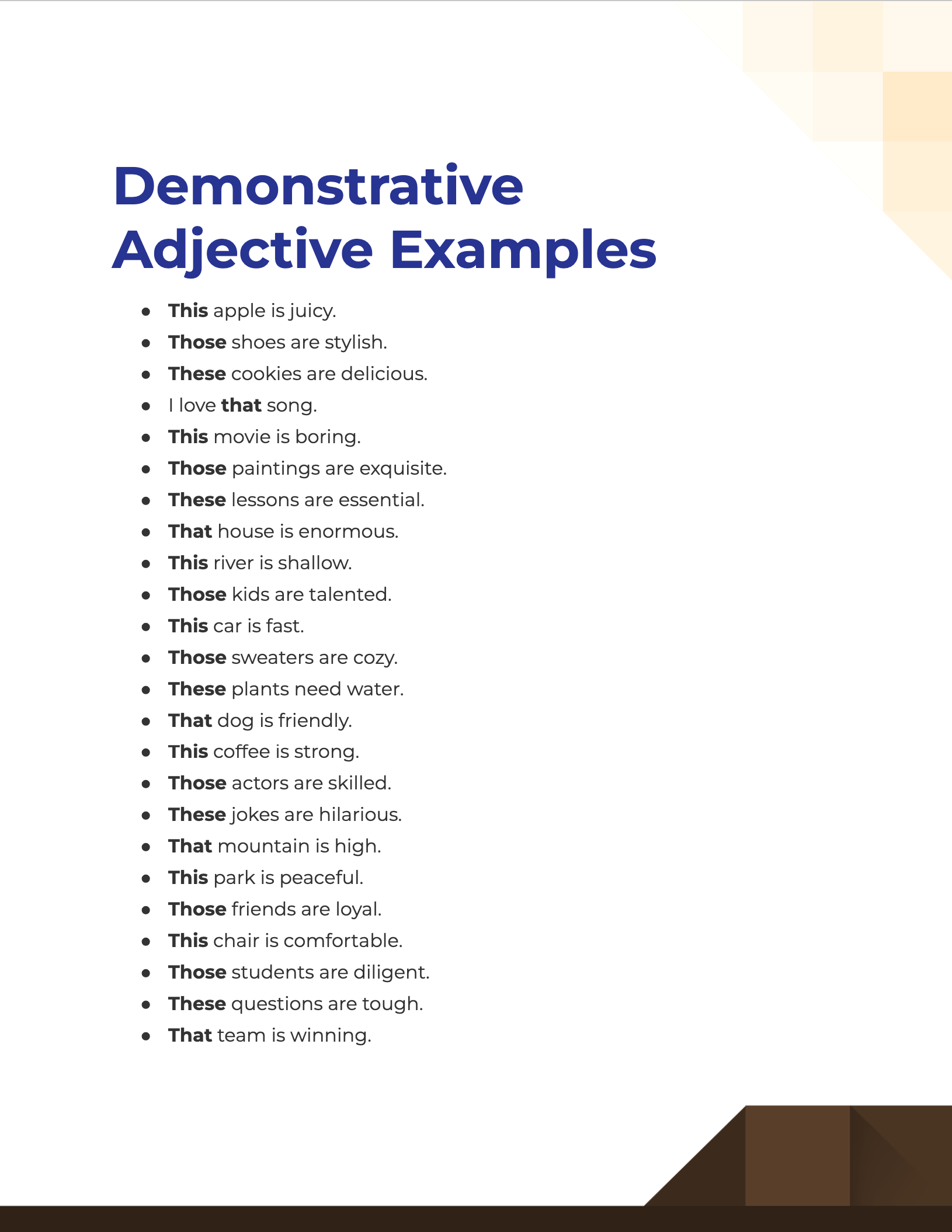99+ Demonstrative Adjective Examples
Get ready to simplify your life with demonstrative adjectives! These small but mighty words can help you point out specific items, clarify your speech, and make your writing pop. Our guide will walk you through a plethora of adjective examples, definitive usage rules, and indispensable tips.
What is the Demonstrative Adjective? – Definition
A demonstrative adjective is a word that modifies a noun by identifying or pointing it out within a sentence. In English, the most common demonstrative adjectives are “this,” “that,” “these,” and “those.”
What is the Best Example of a Demonstrative Adjective?
Consider the sentence, “I prefer this book to that book.” In this example, the words “this” and “that” are demonstrative adjectives. They point out which book is being referred to, providing clarity and specificity to the sentence.
100 Demonstrative Adjective Examples

Demonstrative adjectives are the unsung heroes of the English language. They add clarity, vividness, and a degree of specificity to our sentences. If you’ve ever found yourself puzzled about how to distinctly identify objects or people in your conversations or writings, these examples are tailor-made for you. Below are 100 unique, distinct, and best examples of sentences using demonstrative adjectives.
- This apple is juicy.
- Those shoes are stylish.
- These cookies are delicious.
- I love that song.
- This movie is boring.
- Those paintings are exquisite.
- These lessons are essential.
- That house is enormous.
- This river is shallow.
- Those kids are talented.
- This car is fast.
- Those sweaters are cozy.
- These plants need water.
- That dog is friendly.
- This coffee is strong.
- Those actors are skilled.
- These jokes are hilarious.
- That mountain is high.
- This park is peaceful.
- Those friends are loyal.
- This chair is comfortable.
- Those students are diligent.
- These questions are tough.
- That team is winning.
- This idea is revolutionary.
- Those cities are populated.
- These books are informative.
- That lake is deep.
- This dish is spicy.
- Those dresses are elegant.
- This hat suits you.
- Those flavors are exotic.
- These facts are interesting.
- That shop is closed.
- This vacation is relaxing.
- Those tools are useful.
- These gadgets are innovative.
- That route is quicker.
- This recipe is easy.
- Those exercises are challenging.
- This phone has great battery life.
- Those countries are beautiful.
- These vegetables are fresh.
- That island is remote.
- This show is captivating.
- Those cars are vintage.
- These birds are colorful.
- That photograph is breathtaking.
- This view is amazing.
- Those chocolates are delicious.
- This laptop is powerful.
- Those planets are far away.
- These trees are tall.
- That chair is broken.
- This novel is gripping.
- Those options are better.
- These fruits are ripe.
- That decision was wise.
- This gift is thoughtful.
- Those fireworks are spectacular.
- This area is crowded.
- Those rooms are vacant.
- These tips are useful.
- That solution is effective.
- This jacket is warm.
- Those dishes are dirty.
- These tasks are simple.
- That answer is correct.
- This weather is nice.
- Those trends are popular.
- This exam is difficult.
- Those grapes are sour.
- These lines are long.
- That bridge is historic.
- This moment is precious.
- Those statues are ancient.
- These seats are reserved.
- That flight is delayed.
- This shop is busy.
- Those colors are vibrant.
- This technology is outdated.
- Those beaches are clean.
- These methods are proven.
- That artist is famous.
- This course is useful.
- Those words are meaningful.
- These jeans fit perfectly.
- That landscape is scenic.
- This yogurt is expired.
- Those meetings are important.
- This soup is too salty.
- Those bags are heavy.
- These articles are relevant.
- That conversation was enlightening.
- This restaurant is full.
- Those notes are detailed.
- These scenes are intense.
- That building is old.
- This necklace is elegant.
- Those performances were stunning.
What is an example of a demonstrative adjective?
A demonstrative adjective is a word that is used to point out specific objects, either near or far, in space or time. These adjectives provide context by indicating which item or items you’re referring to, making them essential tools for clear and precise language. For instance, in the sentence, “That book is interesting,” the word “that” is a demonstrative adjective that specifies which book is being discussed. It directly modifies the noun “book,” offering further detail to enhance understanding.
What are the 8 demonstrative adjectives?
While English primarily uses four demonstrative adjectives—this, that, these, those—some people consider “such,” “same,” “either,” and “neither” to be demonstrative adjectives as well. Here’s a brief overview of the 8:
- This: Used for a singular noun that is close in space or time.
- Example: “This apple is ripe.”
- That: Used for a singular noun that is farther in space or time.
- Example: “That movie was amazing.”
- These: Used for plural nouns that are close in space or time.
- Example: “These books are helpful.”
- Those: Used for plural nouns that are farther in space or time.
- Example: “Those trees are tall.”
- Such: Used to emphasize a quality.
- Example: “It was such a beautiful day.”
- Same: Used to indicate identicalness.
- Example: “We had the same idea.”
- Either: Used to indicate one or the other in a pair.
- Example: “You can sit in either chair.”
- Neither: Used to indicate not one or the other in a pair.
- Example: “Neither option is good.”
What are demonstrative adjectives for kids?
When explaining demonstrative adjectives to kids, it’s beneficial to keep the explanation simple and relatable. Demonstrative adjectives are special words that help us know which thing someone is talking about. In English, the main ones are “this,” “that,” “these,” and “those.”
- This is for something that is near you. Like, “this toy” could be a toy you are holding.
- That is for something far from you. If a toy is across the room, you could say, “that toy.”
- These is like “this,” but for many things close to you. If you have many toys next to you, you could say, “these toys.”
- Those is like “that,” but for many things far from you. If many toys are across the room, you would say, “those toys.”
For example, if there are two apples on a table, one near and one far, you could say, “This apple is near me, and that apple is far away.” For many apples, you would say, “These apples are near me, and those apples are far away.”
How to Practice Demonstrative Adjectives?
Practicing demonstrative adjectives is essential for anyone learning English, whether they’re a native speaker or an ESL student. The mastery of these adjectives is a cornerstone for effective communication. Below are some practice methods:
- Flashcards: Create flashcards with sentences using demonstrative adjectives on one side and the meaning or the identified object on the other.
- Example: “This is delicious” could lead to “The food close to the speaker is delicious.”
- Interactive Exercises: Many online platforms offer quizzes and exercises focusing on demonstrative adjectives. Take these tests to reinforce your knowledge.
- Daily Application: Try to incorporate demonstrative adjectives in your everyday conversations. Pay attention to how others use them, too.
- Writing Exercises: Write short paragraphs or stories using as many different demonstrative adjectives as you can. This helps cement your understanding and usage of them.
- Visual Aids: Pictures can be a great way to practice. Point to different objects in a picture and try to use demonstrative adjectives to describe them.
- Role-Playing: This is particularly useful for kids or language learners. Create scenarios that necessitate the use of demonstrative adjectives and act them out.
How to Use a Demonstrative Adjective? – Step by Step Guide
Using a demonstrative adjective correctly can add clarity to your conversations and writings. Here’s a step-by-step guide:
- Identify the Noun: Before you can use a demonstrative adjective, figure out the noun you’ll be modifying.
- Example: Dog
- Determine the Proximity: Are you referring to something close or far?
- Example: The dog is close.
- Check for Plurality: Is it a single item or multiple items?
- Example: It’s a single dog.
- Select the Correct Demonstrative Adjective: Based on proximity and plurality, choose the correct demonstrative adjective.
- Example: “This” for a singular, close object.
- Place Before the Noun: The demonstrative adjective should directly precede the noun it is modifying.
- Final Sentence: “This dog is friendly.”
Tips for Using Demonstrative Adjective
Here are some practical tips for effectively using demonstrative adjectives:
- Clarity Over Ambiguity: Always aim to use the demonstrative that provides the most clarity. If the noun being referred to isn’t clear, you may need additional sentences or context to avoid ambiguity.
- Avoid Overuse: While demonstrative adjectives can be useful for emphasis and specificity, overuse can make your speech or writing monotonous.
- Pair with Gestures: When speaking, pairing your demonstrative adjectives with hand gestures can provide additional clarity, especially in complex or crowded scenarios.
- Review and Revise: If you’re writing, always review to make sure that your demonstratives clearly refer to the intended nouns. If there’s a chance for confusion, consider revising.
- Consult Style Guides: For formal writing, different style guides might have specific rules for using demonstrative adjectives. Be sure to consult these if you’re unsure.
By understanding these tips and applying the practice methods and step-by-step guide, you’ll be well on your way to using demonstrative adjectives like a pro



